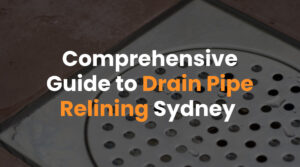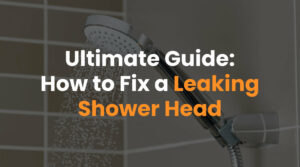Dealing with a leaking shower head can be frustrating, not to mention the potential for increased water bills and unnecessary water wastage. In Australia, conserving water is not just an environmental responsibility; it’s a necessity. This guide aims to equip homeowners with the knowledge to identify the cause of a leaky showerhead and provide step-by-step instructions to fix it, ensuring compliance with local water conservation laws and plumbing regulations.
Understanding Why Your Shower Head is Leaking
A leaking shower head can be caused by a variety of issues, each requiring a different approach to fix:
- Worn Out Rubber Washers or O-Rings: These components create a water-tight seal in joints within the shower arm and faucet body. Over time, they can deteriorate, allowing water to escape.
- Clogged Showerhead: Mineral deposits from water can build up inside the showerhead, disrupting water flow and causing pressure to build up, leading to leaks.
- Faulty Shower Valve: The valve controls water flow and temperature to the showerhead. A malfunction here can result in a leaky or dripping shower head.
- Improper Water Pressure: Too high water pressure can strain the plumbing fixtures, including the showerhead, causing leaks even when the water is turned off.
Tools and Materials Needed to Fix a Leaking Shower Head
Before you begin the repair, gathering the necessary tools and materials will streamline the process. Here’s what you’ll typically need:
- Adjustable Wrench and Pliers: To remove the shower head and access the shower arm or valve as needed.
- Teflon Tape (Plumber’s Tape): To wrap the threads of the shower arm when installing a new shower head or reattaching the old one, ensuring a tight seal.
- Replacement Washers and O-Rings: New rubber components are crucial if the leak is due to worn-out washers or O-rings.
- Shower Valve Cartridge: If the leak originates from a faulty shower valve, a new cartridge may be required.
- Vinegar and Cleaning Brush: To clean mineral deposits from the showerhead, restoring proper water flow.
- Bucket and Rag: To catch any remaining water and clean up after repairs.
Step-by-Step Instructions to Fix a Leaky Shower Head
Fixing a dripping showerhead can stop the annoying drip and save water, ultimately reducing your water bills. Here’s how to tackle a leaking showerhead effectively:
- Turn Off the Water Supply: Locate and turn off the water shutoff valves built into most modern shower faucets. If your type of shower setup doesn’t have individual shutoffs, you may need to turn off the main water supply to your home.
- Remove the Shower Head: Unscrew the old shower arm if necessary, or simply remove the showerhead by loosening it from the shower arm. Be careful not to break the head or damage the threads on the shower arm.
- Clean the Shower Head: Often, leakage in your shower can be due to clogs. Detach and clean the showerhead thoroughly using vinegar to dissolve mineral deposits that cause water to leak or restrict flow.
- Inspect and Replace Faucet Washer: Inspect the faucet washer attached to the shower and replace it if it’s worn out. A faulty faucet washer kit can be a common reason your shower head is leaking.
- Wrap the Shower Arm Threads: Use Teflon tape to wrap the shower arm threads securely to ensure a tight seal between the shower arm and the showerhead, preventing water from leaking.
- Reattach the Shower Head: Screw the new shower arm in place or simply reattach the entire shower head to the arm, ensuring it’s securely fastened to stop any dripping.
- Test Your Repair: Turn on the water supply and observe the fixed showerhead. If water is dripping has stopped and the showerhead is leaking no more, you have successfully learned how to fix a leaky shower head.
Identifying and Repairing a Faulty Shower Valve
A faulty shower valve can cause your shower to leak, leading to continuous water wastage. Here’s how to address this issue:
- Diagnose the Faulty Valve: First, identify the shower valve as the source of the leak. Signs include a shower handle that doesn’t fully stop water flow or water leaking from the faucet handle.
- Access the Shower Valve: Remove the shower handle to access the valve. This may involve unscrewing a cover plate or using a specific tool to remove the handle without causing damage.
- Inspect the Valve: Look for any visible signs of wear or damage to the valve components. Shower valves have water shutoff capabilities that may fail over time, requiring adjustment or replacement.
- Repair or Replace the Valve: Depending on the type of shower and the extent of the damage, you may need to replace the entire valve or just certain components. This might require removing the faucet body or accessing the valve from behind the shower fixture.
- Test the Valve: Once the valve has been repaired or replaced, reattach the shower handle, turn on the water supply, and test the shower for leaks. Adjust the toilet repair as necessary to ensure the leak has been fixed.
How to Replace a Shower Cartridge for a Dripping Showerhead
Replacing a shower cartridge is essential for fixing specific types of leaking showerheads, especially in showers where the cartridge regulates water flow and temperature:
- Shut Off Water Supply: Ensure the water supply to the shower is completely shut off to prevent leaking water during the repair.
- Remove Shower Handle: Unscrew and remove the shower handle to access the cartridge. This may require careful maneuvering to avoid damaging the shower fixture.
- Extract the Old Cartridge: Identify the shower cartridge within the faucet body. Use pliers to carefully pull out the old cartridge, being mindful of the water shutoff valves and the seal between the shower and the cartridge.
- Install the New Cartridge: Screw the new shower cartridge into place, ensuring it’s correctly aligned and securely fitted. The new cartridge should match the specific shower tank model and design for a proper fit.
- Reassemble and Test: After installing the new cartridge, reattach the shower handle and any other removed parts. Turn on the water supply near the shower, and test the shower for any signs of dripping or leakage.
DIY Tips: Fixing a Leaky Shower Faucet
Fixing a leaky shower faucet is a common household repair that can prevent water wastage and save on water bills. Here are some DIY tips to help you fix leaking shower fixtures effectively:
- Identify the Source of the Leak: Before attempting any repair, identify where the shower head leaking is originating from. This could be due to a faulty faucet, worn-out washers, or damaged seals.
- Shut Off the Water Supply: Always start by turning off the water supply. Shower faucets have water shutoff valves, typically located behind the shower wall or underneath the sink.
- Disassemble the Faucet: Carefully remove the shower handle and faucet body. Be mindful of threads inside the showerhead and the faucet assembly to avoid breaking any parts.
- Inspect and Replace Worn Parts: Look for signs of wear on the washers and seals. Replacing these components can often fix leaking shower faucets and stop a dripping shower head.
- Reassemble and Test: After replacing any faulty parts, reassemble the shower faucet and turn the water supply back on. Test the shower to ensure the problem has been fixed and notice if water leaking has stopped.
Sealing and Preventing Water Leaking from the Showerhead
A leaking showerhead can be annoying and wastes significant amounts of water. To seal and prevent leaks, consider the following:
- Tighten Connections: Sometimes, a shower head may leak due to loose connections. Tighten the shower head back onto the shower arm, ensuring it’s secure. Shower heads with swivel connections may require extra attention to ensure they’re tightly fastened.
- Replace Damaged Components: If the showerhead is stuck or if you notice wear, it might be time to replace certain parts or the entire shower head to ensure a proper seal.
- Use Teflon Tape: Wrapping Teflon tape around the threads of the shower arm can help seal the connection between the shower head and the arm, preventing water from leaking.
When to Replace a Showerhead vs. Repairing It
Deciding whether to replace a showerhead or repair it depends on a few factors:
- Age and Condition: If the shower head is old or significantly damaged, replacing the shower might be more cost-effective than attempting repairs.
- Cost of Repairs: Evaluate the cost of repairing the shower head versus purchasing a new one. In some cases, fixing the showerhead, especially if it involves replacing multiple parts, can be more expensive than a replacement.
- Water Efficiency: New shower heads often come with better water efficiency. If your current shower head is leaking and outdated, upgrading to a new model can help save water and reduce your bills.
- Difficulty of Repairs: If the shower head is stuck or if repairs require specialised tools, it might be simpler and quicker to opt for a replacement. However, if you can easily identify and fix the problem, repairing the existing showerhead can be a viable option.
Maintenance Tips to Prevent a Leaky Shower Head
Ensuring your shower remains leak-free involves regular maintenance and attention to detail. Here are some tips to keep your shower head in optimal condition:
- Regular Cleaning: Mineral buildup from hard water can cause a shower head to clog and leak. Regularly clean your showerhead by soaking it in vinegar to dissolve deposits and ensure smooth water flow.
- Check and Replace Washers and Seals: Over time, washers and seals within the shower faucet can wear out, leading to leaks. Inspect these components periodically and replace them if they show signs of deterioration to fix a dripping shower head effectively.
- Tighten Connections: Loose connections can lead to water leaking. Ensure that all parts of the shower, including the showerhead and faucet body, are tightly secured. Be cautious not to overtighten, as this may break the head or damage threads.
- Monitor Water Pressure: High water pressure can strain your plumbing fixtures, including shower heads, causing leaks. Installing a water pressure regulator can help maintain optimal pressure and prevent issues related to excessive force on your showerhead.
Common Mistakes to Avoid When Fixing a Leaking Shower
DIY repairs can be effective, but certain pitfalls can complicate the process or even exacerbate the problem. Here are common mistakes to avoid:
- Overlooking the Root Cause: Before attempting to fix a leaking shower, accurately identify the source of the leak. Fixing the shower head without addressing a deeper issue, like a faulty shower valve, may not resolve the problem.
- Using Mismatched Parts: Ensure that any replacement parts are compatible with your shower model. Using incorrect components can lead to poor fits and continued leaks.
- Overtightening Components: While it’s important to secure connections, overtightening can damage threads or crack the shower head, making the leak worse.
- Neglecting Regular Maintenance: Regularly inspecting and cleaning your shower can prevent many issues. Neglecting maintenance can lead to more significant problems down the line.
Conclusion: Ensuring a Leak-Free Shower Experience
A leaking shower head is not just annoying but also wastes water and increases your bills. By following the outlined steps to fix a showerhead and adhering to preventive maintenance tips, you can ensure a leak-free shower experience. Regular inspections and timely repairs can fix leaky shower faucets and stop the frustrating shower head drip. However, if you notice water leaking despite your best efforts, it may be time to repair a leaking component or consult a professional like Plumbwell Plumbing Services on (02) 9064 2861.








